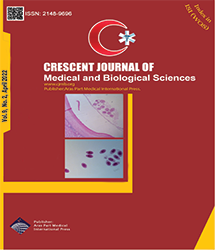| Original Article | |
| Comparison of First-Trimester Screening Biomarkers in Spontaneous (Natural) and In Vitro Fertilization Pregnancies | |
| Mojgan Barati1, Mahvash Zargar1, Bahareh Asan1 | |
| 1Obstetrics and Gynecology, Fertility Infertility and Perinatology Research Center, Ahvaz Jundishapur of Medical Sciences, Ahvaz, Iran | |
|
CJMB 2022; 9: 109-115 DOI: 10.34172/cjmb.2022.19 Viewed : 2964 times Downloaded : 3788 times. Keywords : IVF, first-trimester screening, free β-HCG, PAPP-A, NT |
|
| Full Text(PDF) | Related Articles | |
| Abstract | |
Objectives: The present study was designed to evaluate and compare the screening markers of spontaneous and in vitro fertilization (IVF) pregnancies in individuals who underwent combined screening in the first trimester of pregnancy. Materials and Methods: In this retrospective study, we examined the difference between natural and assisted-reproductive technology (ART) pregnancies in 2252 mothers from January 2011 to October 2019. In both groups, the first trimester screening parameters including NT, free beta-human chorionic gonadotropin (β-hCG), and PAPP-A were measured. Results: According to the results of the present study, BMI was higher in the group that became pregnant by IVF compared to the normal pregnancy group (P < 0.001). Additionally, in patients using IVF, the history of maternal disease was less frequent compared to the other group (P = 0.003). Most cases of twin fetuses, dichorionic twin pregnancy, and fetal abnormality were seen in the IVF group. Although the β-hCG and free PAPP-A levels were high in the IVF group, no significant difference was observed. The group with spontaneous pregnancy had a higher penetration rate of nuchal translucency <95th percentile compared to the IVF group (P < 0.001). The results of comparing the first trimester test showed that in the IVF group, 81.3% of patients were at low risk and 6.6% were at high risk, while in the normal pregnancy group, 78.9% of patients were at low risk and 7.0% of them were at low risk, indicating that the difference was not significant. Conclusions: Overall, although the risk of aneuploidy in IVF pregnancies was not higher compared to normal pregnancies, in IVF pregnancies, NI is associated with a high risk of fetal abnormalities. Therefore, NT sonography can help to diagnose fetal anomalies especially aneuploidy |
Cite By, Google Scholar
Online Submission System
 CJMB ENDNOTE ® Style
CJMB ENDNOTE ® Style
 Tutorials
Tutorials
 Publication Charge
Medical and Biological Research Center
About Journal
Publication Charge
Medical and Biological Research Center
About Journal
Aras Part Medical International Press Editor-in-Chief
Arash Khaki
Deputy Editor
Zafer Akan



















